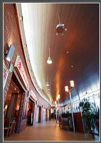
Question: Your firm has worked on a number of high profile retail projects. How are high-end brands leading the pack in retail design?
Lisa: Our clients, including Bloomingdale's and Saks Fifth Avenue, know that their customers are conscious of and savvy about good design. The customers are well travelled and have high expectation levels for their surroundings and the services that a store can provide. Additionally, their customers are familiar with the in-store image that many of the leading designers make beyond the store's environment. A store's look is a very significant part of a brand's image.
Lisa's Recommended Reading
One Off: Independent Retail Design - by Clare DowdyDDi magazine
Branding a Store: How to Build Successful Retail Brands in a Changing Marketplace by Ko Floor
Question: Broadly speaking, how do you see the retail setting changing in five years?
Lisa: Retailers are beginning to realize that they can't be everything to everyone and will continue to edit their offerings as they understand their customers' base desires. As well, retailers are starting to concentrate more on niche markets as opposed to attempting to be too broad. I believe that store interiors will not only respond to the lifestyle of their customer base, but also reflect the neighborhood and surroundings of their location. This will be a switch from the cookie cutter looks.
Question: Tell us about a progressive or unusual project you are currently working on, or have recently completed.
Lisa: Bloomingdale's in Santa Monica (opening in August) is an important statement for this famous merchant. Similar in concept to Bloomingdale's SoHo, which opened in 2004, Santa Monica will be an edited assortment of merchandise that responds to a younger-thinking contemporary customer. There are subtle beach references with contradictory materials such as weathered woods, concrete, and glass-an homage to the Southern California lifestyle: relaxed, sophisticated, contemporary.
Question: While online shopping is gaining in popularity, the ability to touch a product, and the social aspect of shopping keep it relevant in the offline world. Yet do you see a further integration of technology and retail design?
Lisa: Technology is advancing so quickly that retailers must understand how and where to use it to best suit their brand. Using interactive systems-where a shopper can scroll through a brand's offering or look at inventory that reflects all the stores-is extremely practical. It saves time for the shopper and instills goodwill towards the retailer.
Question: Talk to us about the retail floor plan. Has it changed or will it change in recent years? Perhaps low-end brands will space out and showcase products in a way that high-end brands traditionally do?
Lisa: Well thought-out circulation has always been essential. Yes, many stores are finding it beneficial to reduce the amount of merchandise on the sales floor. This allows the merchandise that is displayed to appear special and therefore more appealing to the customer. For example, moderately priced stores, like H&M and Topshop, have great visuals, and they are leaders in these trends in visual merchandising, which capture the customers' attention and make them want to buy. And that is what it's all about, isn't it?
Question: Tell us something unusual about yourself.
Lisa: I am a true Gemini (which has its pluses and minuses), but it gives me the ability to use both the right side and left side of my brain. I can creatively conceptualize ideas, spaces, and environments and know how to actually build it and get it done.



















